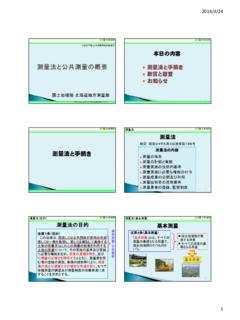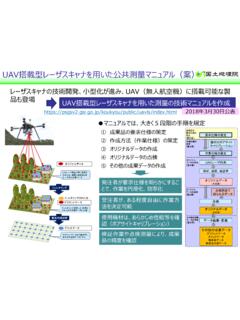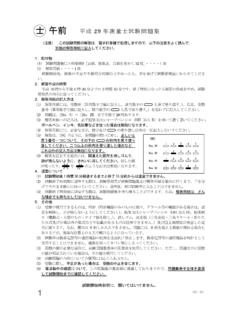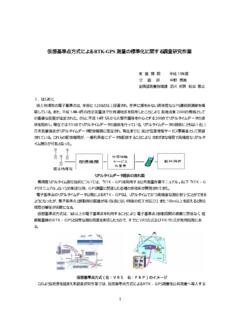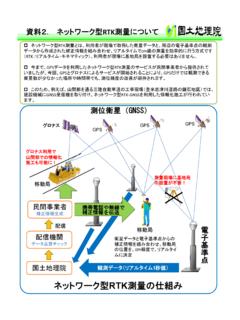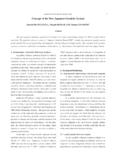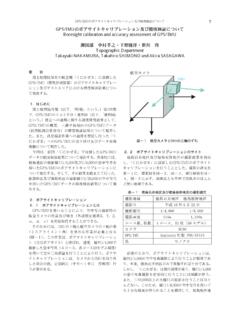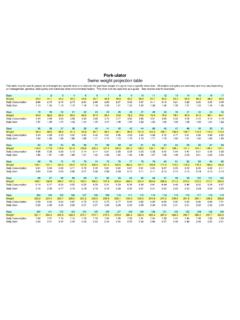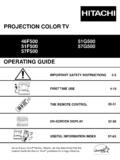Transcription of Concise Derivation of Extensive Coordinate Conversion ...
1 Concise Derivation of Extensive Coordinate Conversion formulae in the Gauss-Kr ger projection 1. Concise Derivation of Extensive Coordinate Conversion formulae in the Gauss-Kr ger projection Kazushige KAWASE. Abstract Although the set of Gauss-Kr ger projection formulae recognized and used worldwide thus far is the 2nd formulae , which is limited to use within certain longitudinal zones, the recently discovered usefulness of the 1st formulae , which can be applied to Extensive areas on the globe, has been understood from a new perspective. The formulae are favorable in view of the modern computer environment, in which they are of importance for recognizing details comprehensively, not only in the discipline of survey and mapping but also in geospatial information management. In this paper, I try to elaborate a comprehensive Derivation of these formulae , including those for meridian convergence and scale factor, so that anyone interested in geospatial information management can understand them with minimum background knowledge.
2 1. Introduction of indispensable background knowledge needed for In 1912, just one century ago, Johannes Heinrich comprehension. Louis Kr ger published Konforme Abbildung des In this short report, a comprehensive Derivation Erdellipsoids in der Ebene (Conformal Mapping of the process for the Extensive coordination Conversion Earth Ellipsoid to the Plane; Kr ger, 1912). In this article, formulae in the Gauss-Kr ger projection is explicated two kinds of formulae to describe Coordinate Conversion using nothing but a basic concept of elementary complex appeared. The set of formulae that appeared in the first analysis as background knowledge. In this paper, I first part of the article (which we will hereafter call the 1st show consecutive step action flow to describe how to formulae ) is applicable to Conversion for Extensive perform the necessary steps in order to achieve the areas on the globe.
3 In contrast, the set of formulae that desired Conversion (section 2). Next, in section 3, I. appeared in the second part of the article (which we will present all the formulae , including those for meridian hereafter call the 2nd formulae ) is restricted to usage convergence and scale factor m. In section 4, I give within certain longitudinal zones. Notwithstanding their a step by step explanation of their Derivation ; finally, I. capacity for general usage, the 1st formulae appear to conclude this report in section 5. have been less useful than the 2nd formulae , owing to the intricacies of the whole formulaic system as well as 2. Displaying step action flow for Conversion the roundabout Derivation process described in Kr ger's The consecutive step action flow of the original article.
4 Extensively applicable Coordinate Conversion in the Under these circumstances, Karney (Karney, Gauss-Kr ger projection is presented as follows: 2011) opened our eyes to the fact that the 1st formulae are in harmony with the present computing environment. 1. Regard the earth as an oblate ellipsoid with Based on this fact, some commentaries ( , Deakin et semi-major axis a and the 3rd flattening n. (As al., 2011) have been reported. Deakin et al. explain these a rule, the earth ellipsoid is identified by two formulae both via Gauss-Lambert and Gauss-Schreiber parameters the semi-major axis and the inverse projections. Although these commentaries help us to 1st flattening F, hereafter however, we use grasp the concepts underlying the 1st formulae , there is n=1/(2F 1) instead of F.).
5 Room for improvement in terms of reducing the amount Assign geographic latitude and longitude as 2 Bulletin of the Geospatial Information Authority of Japan, March, 2013. geographic coordinates on the surface of the earth holomorphic function of the form ellipsoid.. 2. Transform geographic coordinates to Cartesian = + . k =1. k sin 2k , (5). coordinates by normal Mercator projection . At this point, introduce isometric latitude , which is and inverse form, defined as . 2 n 2 n . = k sin 2k . (6). 1. = gd tanh 1 sin . (1) k =1. 1+ n . 1+ n At this point, determine the values of the Fourier Here, gd x denotes the inverse function of the 1. sine coefficients { k} that appear in formula (5). Gudermannian function gd x, which is defined as so that the value of argument on the real axis of the ' -plane coincides with rectifying latitude , x dt defined as scaled latitude by meridian arc length, gd x =.
6 0 cosht (2) , 1 1. = sin tanhx = tan sinhx .. = + . k =1. k sin 2k . (7). 3. Assign a desired meridian, with longitude 0. , as a central meridian and set . Regard the 6. Finally, multiply both coordinates and by acquired Mercator projection plane as a complex the product of central meridian scale factor m0. plane in which the central meridian is set up as and rectifying radius A in order to obtain plane the real axis, and the equator, as the imaginary rectangular coordinates easting X and northing Y, axis; , = +i , where i= 1 denotes the which coincide with an appropriate scale of the imaginary unit. real world. 4. Perform a conformal mapping from the -plane The rectifying radius is defined as the corresponding into a complex plane ' = ' + i ' using the radius of the circle whose perimeter coincides Gudermannian function, which, as a matter of with the entire meridian arc length of the earth course, can be regarded as a holomorphic function ellipsoid.
7 (complex regular function) on the domain under discussion; , We note that with regard to the details of the determination of the Fourier sine coefficients { k} and = gd = gd ( + i ) . (3) { k} that appear in step 5, as well as the Fourier sine coefficients { k} that appear in the first part of formula This mapping is performed in order to normalize (13), presented in section 3, a comprehensive summary the range of the variable of isometric latitude has already been given by Kawase (Kawase, 2011). ( ) to that of conformal latitude ( / 2 / 2 ) on the real axis of the '-plane 3. Displaying all the Extensive Coordinate Conversion in order to enable the dual-form transformations formulae in the Gauss-Kr ger projection performed in the next step, , On the basis of the step action flow shown in the previous section, we write all the forward and inverse 1.
8 Gd = sin tanh = tan sinh = . 1 (4) Coordinate Conversion formulae in the Gauss-Kr ger projection . Note that the roles of coordinates X and Y. 5. Perform a conformal mapping from the ' in the Japanese surveying and mapping community -plane into a complex plane = + i using a is contrary to that displayed below, , in Japan, X. Concise Derivation of Extensive Coordinate Conversion formulae in the Gauss-Kr ger projection 3. traditionally denotes northing while Y denotes easting. ( , 0. , = 0: given).. X = m0 A +.. k =1. k cos 2k sinh 2k , Y = m0 A +.. k =1. k sin 2k cosh 2k .. (8). 1 + tan2 + tan tan . , m = m A 1 + 1 n tan . 2. 2 + 2. = tan 1 (9). 1 + tan2 tan tan . 0.. a 1 + n tan 2 + cos 2 . 2 n 2 n . tan = sinh tanh 1 sin tanh 1 sin (10). 1+ n 1+ n .. sin . tan (11). = tan 1 , = tanh 1.
9 Cos 1 + tan2 .. =1+ . k =1. 2k k cos 2k cosh 2k , = 2k . k =1. k sin 2k sinh 2k (12). ( 0, X, Y: given).. sinh . = + . k =1. k sin2 k , = tan 1 , = 0 + . cos . (13). A 1 n cos 2 + sinh 2 . 2. + tan tanh . = tan 1 , m = m0. 1 + tan (14). tan tanh a 1 + n 2 + 2. 1 1. = Y, = X (15). m0 A m0 A.. = . k =1. k sin 2k cosh 2k , = . k =1. k cos 2k sinh 2k (16).. =1 k =1. 2k k cos 2k cosh 2k , = 2k . k =1. k sin 2k sinh 2k (17). sin . = sin 1 (18). cosh . 4 Bulletin of the Geospatial Information Authority of Japan, March, 2013. 4. Explanation of the Derivation of each formula Derivation of the main Conversion sin cosh + i cos sinh . In this section, we confirm the formulae displayed sin + tanh (i ) sin + i tan . = =. in the previous section one by one. First of all, we define 1 + sin tanh (i ) 1 + i sin tan (23).
10 Real variables , , and ', ' as =. (1 + tan2. ) ( 2. sin + i 1 sin tan ). 1 + sin2 tan2 . d d 1. i = , + i = = . (19). d d i . Regarding the equivalence of the real and From formulae (5), (6), and (19), along with the imaginary parts of both sides of formula (23) as properties of complex trigonometric functions in terms simultaneous equations, and bearing in mind , of the real and imaginary parts of their arguments ( , we can obtain the appropriate solutions with respect to Abramowitz et al., 1964) as well as the procedure for sin and tan as step 6 in section 2, it is not hard to derive formulae (8), (12), (15), (16), and (17). sin sinh . sin = , tan = , (24). As for formula (10) , we can easily derive it from * cosh cos . formulae (1) and (4) directly. from which we derive the second part of formula (13).

